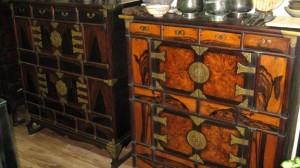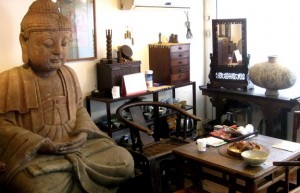Seoul offers some splendid opportunities for picking up antiquities and crafts. We here at WoWasis visited three distinct areas, and each of them have their own character, Insadong, the Janganpyeong Antiques Market, and the Bogwang-ro and Noksapyeong-daero 26-gil area just south of Itaewon. Let’s start with the best, and work our way down.
Insadong has the finest antiquities and crafts shops, hands down. For high-end Asian furniture and pottery, we recommend Insadong 10-gil. Two shops in particular stood out, although a number of them were exceptional. Koryeobang featured wonderful pieces and a friendly shopkeeper. Just east of Koreyobang (turn left out the front door, cross the street, then turn right down the next alley (if you reach Samilro, you’ve gone too far), you’ll find Hong Sun Ho’s Gwan Go Jae gallery. Sun Ho is a third-generation dealer in antiquities, speaks very good English, and has wonderful pieces in his small shop. There are a number of other shops worth looking into on Insadong 10-gil and Insadong 9-gil.

Library cabinets, such as these at Gwan Go Jae, are found in several shops in the Insadong and Janganpyeong areas
There are remarkable crafts shops all up and down Insadong, too, selling everything from Hahoe masks to formidable examples of ceramic arts. For the former, we recommend the Talbang Traditional Mask shop, which features the masks of master carver Jung Sung Am. You can either buy his decorative pieces or authentic performance masks, which are differentiated by the green back cloth, among other things (which include holes for hair, different pigmentation, and mouth strings). For ceramics, we liked the Yeha shop on Insadong 12-gil.
Once a year, the entire Insadong art community holds a mammoth exhibition involving virtually all galleries, crafts shops, and antiquities stores, and publishes a world class catalogue, including maps to the shops, photographs, and descriptions. For more on next year’s exhibit, visit www.hiinsa.com
The second area worth investigating consists of three buildings near the Dapsimni metro station on Line 5. Collectively called Janganpyeong, two buildings can be found across the street from each other. At exit 2, cross the parking lot and you’ll see two large orange buildings. Few of the proprietors speak English, the shops are disheveled, but there are interesting items there. After you’ve seen what’s in those two buildings, return to exit 2, turn left (east), and walk down the street for 10 minutes to the third Jaganpyeong building, which can be identified by all the stone statuary outside. Here, you’ll be rewarded by visiting the shop of Mrs. Hwang In Sun called Jangan Antique. She has a host of magnificent pieces, Korean and Chinese, as well as reproductions, so do ask about authenticity while you’re there.
The third area consists of the Bogwang-ro and Noksapyeong-daero 26-gil streets, in the area just south of Itaewon metro station. The area is, frankly, disappointing. Virtually all shops carry European and North American pieces that wouldn’t be considered top class in their own countries. It appears that these dealers bought a lot of minor-to-mediocre pieces, shipped them to Korea in large containers, then threw them in shops. Clearly, these shops are meant for Korean shoppers, as savvy European and North American buyers of antiquities can find better goods in their own countries. Our recommendation is to stay away from the Itaewon area if you’re interested in quality Asian older pieces, and instead, start your search in Insadong.

Leave a Reply